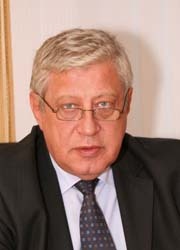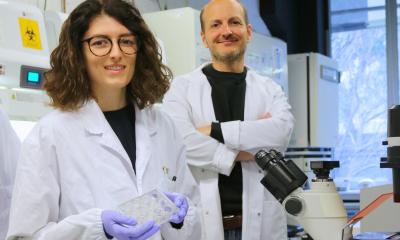Russia's continuing laser medicine advances
For the past 30 years, in the former USSR and Russia, laser medicine has been actively developed and regular annual conferences have opened new avenues for its use by the country's doctors.

The Laser Medicine in the 21st Century conference, held in Moscow this June, drew together 296 laser experts, physicians and scientists, engineers and biophysicists, to attend 82 seminars and 18 posters presented by researchers from Russia and former Soviet countries as well as from Germany, Finland, Bulgaria, USA, Israel, India and Iran.
One of the key presenters, Professor Alexander Geynits MD PhD Dr Sc (med), Director of the State Research and Clinical Centre for Laser Medicine (Moscow), Healthcare Ministry of Russia, pointed out that Russian researchers have produced 456 studies in laser medicine during the last three years alone. ‘75% of these has been patented,’ he told us in a recent EH interview, explaining the difficulty of choosing which to highlight.
Among recent developments presented, were new approaches for photodynamic therapy. ‘Our specialists began to treat, very successfully, non-tumoural lesions (ENT inflammatory pathologies, dermatological problems such as psoriasis, acne vulgaris), whereas worldwide photodynamic therapy is traditionally used only for malignant neoplasms.
‘In cosmetology our specialists use super-pulsed (wavelength 800 and 940 mm) diode lasers combined with cooling, various protectors and immuno-modulators for prophylactics of hyper-pigmentation, herpes and other complications of plastic surgery.
Our specialists have developed combined techniques with high- and low-level laser light and biologically active bandages immobilised with natural and synthetic polymer carriers to treat combustions, trophic ulcers, purulent wounds, which makes wounds heal quicker and reduces pain syndrome better than traditional therapy.
‘Extracorporeal photohaemotherapy has turned out to be effective in patients with chronic arterial insufficiency in the lower extremities. It is especially important for patients with diabetes mellitus. The positive effect has been confirmed not only subjectively but also objectively with isotopic examinations of arterial blood flow and microcirculation system, with better rheological indexes and lipid profile. All examinations were performed dynamically.
‘Fundamental research has focused on laser light effects on the microcirculation system, platelet functioning, the role of oxyhaemoglobin photo-dissociation in vivo in the mechanisms of biostimulation and the therapeutic effects of low-level laser light.
Surgery
‘The conference Organising Committee received over 300 abstracts, each with some novelty in laser medicine. 95 were devoted to laser surgery on various organs and systems.
‘Recently, Russian specialists have received new, effective and safe laser surgical devices (CO-2 laser Lancet, YAD-Nd laser Raduga-1, diode surgical lasers) which enabled them to develop hi-tech surgical interventions on the gastrointestinal tract, liver, gall-bladder – for example, laparoscopic cholecystectomy, appendectomy, echinococcectomy – where the laser scalpel reduces surgical time, decreases complications in sterilising the wound surface, and reduces pain syndrome in the post-operative period compared with traditional surgical techniques.
‘Our scientists successfully use the laser scalpel for laparoscopic abdominal operations in children, particularly for urgent operations for acute appendicitis complicated by peritonitis, for peritoneal commissures, large abdominal neoplasms and large burn wounds. Due to the specific properties of laser light having good haemostatic, dissection and bactericidal effects, treating children with such serious pathologies brings considerably improved outcomes, making the postoperative period smoother and less painful, and reducing their hospitalisation time.’
In addition, the professor added: ‘Our dermatologists have developed a new laser device with the wavelength at the Sore band of the optic spectrum, which is combined with photosensitisers and gives astonishing results in treating psoriasis, acne vulgaris, pyodermas and other difficult-to-treat skin pathologies. Comparative research on the application of low-frequency laser-magnet therapy combined with traditional therapy in deforming osteo-arthrosis of knee joints has shown that this combination, of laser and magnet fields, applied at definite intervals and traditional approaches brings synergic effect when all components potentiate one another.’
New Russian technology
Asked about his country’s new medical technology developments, Prof Geynits listed the following diagnostic equipment: Optic coherent tomograph (Novgorod, Russia) to study tissue structure in various pathologies; diode laser spectroscopy (Moscow, Russia) to detect trace molecules in exhaled air; laser Doppler flowmeter (Moscow, Russia) when used with a newly developed diagnostic technique allows assessment of microcirculation in tissues more precisely; a laser optic/acoustic diagnostic system for non-invasive biopsy (Moscow, Russia) for diagnostics and mapping of blood vessels – it can be used, for example, for early breast cancer detection. I also would like to add new laser correlative spectroscope, which can be used for blood serum diagnostics to reveal tumours and their recurrences in the head and neck (St-Petersburg, Russia); a new laser medical device based on copper-vapour for photodynamic therapy of oncological diseases (Tomsk, Russia); an original laser medical complex, which has no analogues anywhere in the world, for hyperthermia of biological tissues, which can be used for cartilage correction with pre-determined configuration (Moscow, Russia).
Current research
In the works, he mentioned new techniques for diagnoses of tumoural diseases based on fluorescent imaging induced with optic irradiation; complementary diagnostics, including spectral characteristics of bio-tissues and structural modifications; new photosensitisers of the third generation, having better selectivity for accumulation in tumours, better clearance from tissues that allows their application for more extended tumours than before and to decide problem side effects, such as long-lasting skin photo-toxicity. Finally, he added, ‘Mechanisms of structural-functional changes in pathology in biological targets (cells, tissues, whole organs) are being studied with various techniques but laser irradiation provides the most adequate bio-detector.’
01.09.2009











